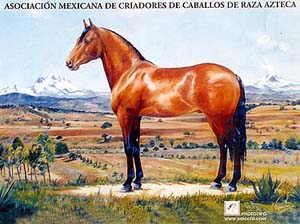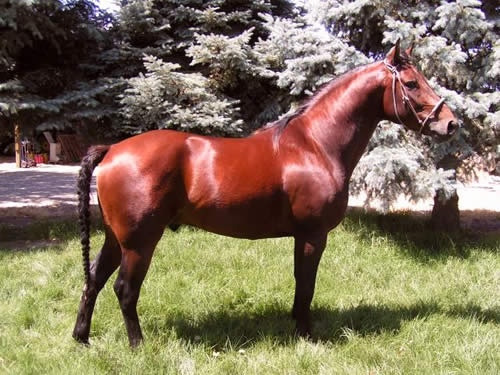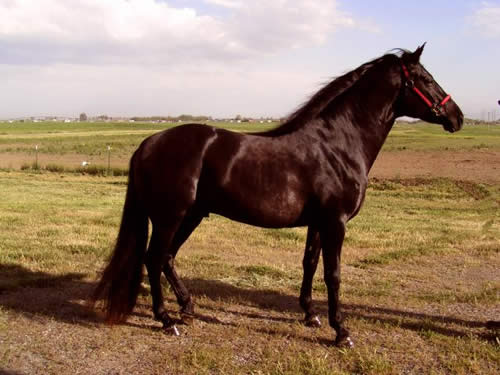The Azteca is a young phenotype breed developed in Mexico during the 1970’s when several of the country’s distinguished horse breeders, government officials, veterinarians and genetic experts worked together to realize their dream of creating Mexico’s first native equine breed. They had in mind a horse resembling the Mexican Criollo of Spanish descent which played a rich part in the country’s history though not native and nearly extinct today.
Early on Quarter Horses and a few select Mexican Criollo mares were crossed with Andalusian stallions by numerous ranch owners. Soon the Mexican Association of Azteca Horse Breeders was established. *In 1982, after having approved the crossbreedings that took place at stud farms belonging to the Mexican Azteca Association, the association was awarded, by way of the government’s Secretary of Agriculture and Livestock, official Patent Number 3585-RP and the official Azteca Studbook was initiated.
El Caballo Azteca
Basically, the Mexican Azteca Crossbreeding Chart allows Andalusian, Lusitano and Quarter Horses to be crossed as long as there are no more than 3/4’s and no less than 3/8’s of either foundation breeds in the offspring. The end result of the crossbreeding chart is to reach the Azteca “A” level which takes at least 3 generations. The Azteca “A” horse can be no more than 5/8’s and no less than 3/8’s Andalusian, Lusitano or Quarter Horse.
In Mexico, Aztecas to be used for breeding must pass two phenotype inspections (six month old foal at dam’s side and a final inspection at 3 years of age).
The versatile Azteca possesses many favorable characteristics including elegance, nobility, boldness, intelligence, willingness, agility, cow sense, power and strong backs which round easily giving an ease of hindquarter engagement. A correctly conformed Azteca is a very functional horse well suited for most of the popular equine disciplines of the day. See our photo gallery for examples of what they can do.


History
The Azteca is the result of a great love of horses in Mexico. Mexico has always had a great interest and admiration for horses and equine sports. Although various equine breeds existed in the country, there was no native Mexican breed. Even the Criollo horses that so valiantly served their masters in the Mexican Revolution which was fought on horseback were not truly a native breed. The hardy Criollos were descendants of Spanish stock introduced by Spanish colonists. During the Revolution, many of these horses were killed and breeding had all but stopped resulting in near extinction of the Mexican Criollo horse.
In the early 1970’s, a group of distinguished horsemen took on the task of creating a breed of horse native to Mexico. They wanted a horse possessing its own specific conformation, characteristics and set of purposes. They envisioned a horse reminiscent of the Criollo so often depicted in works of painters and photographers that recorded the period of the revolution. They desired a graceful, manageable horse to work and ride that possessed an aptitude for the highly popular Charreria. It was decided that the breed with the desired characteristics could be developed by carefully crossing Spanish Andalusian stallions to Quarter Horse and Criollo mares of certain specific types.
After various attempts at crossing some of Mexico’s best imported Andalusian stallions with Quarter Horse and Criollo mares at the Domecq Center of Equine Reproduction in Texcoco, a horse displaying the desired characteristics appeared. These early crosses were given the name Azteca by some of the country’s charro association members. The charro requires a flashy horse that is not too tall but of a suitable height for colea, the taking down of a bull by its tail, a horse quick enough to keep up with the cattle and strong and balanced to throw them. The horse must be calm enough for roping, yet be agile and quick for reining in the Mexican cala. The Azteca is bred to be a perfect mount for the charro.
The early breed founders quickly realized the need for a formal qualification system in order to realize a Mexican horse which meets the established standards of conformation, not the random result of breeders raising the horses they thought were appropriate. The Asociacion Mexicana de Criadores de Caballos de Raza Azteca was founded in 1972 to establish parameters for inclusion in their registry. The breeders association was officially recognized by the Agriculture and Cattle Secretary of the Mexican government, and they worked together with veterinarians and experts in genetics and breeding to develop a scientific breeding program for the Azteca horse.
The Mexican government took a great interest in the development of this breed including honoring the Azteca with the National Horse of Mexico title. An Azteca breeders seminar was held in 1985 to finalize a crossbreeding plan to serve as the foundation in creation of the new breed. The crossbreeding plan for arriving at a pure Azteca A was determined, and the different stages of crosses toward this were classified as E, F, D, C and B.
The Azteca A is a product of a minimum of three generations of the five intermediate stages. Several combinations of different level Aztecas can be crossed to obtain the Azteca A level as long as the resulting offspring has the accepted ratios of breed contributions. This way the particular traits of the Azteca are assured. The letters used (E, F, D, C, B, A) are not a grading system to indicate quality but only an indicator for breeding purposes to guarantee that no contributing foundation breed figures too prominently in the offspring. The foundation Azteca horse may not carry more than 3/4th’s the blood of either Spanish or Quarter Horse and no more than 1/4th Criollo. A purebred Azteca “A” may be no more than 5/8’s Spanish or Quarter Horse and no more than 1/4th Criollo.
Azteca Characteristics
A well bred Azteca is a beautiful combination of the qualities admired in the Spanish and Quarter Horse. Like both the Spanish and Quarter Horse, the Azteca is compact in build and powerfully muscled without being heavy. One way to visualize an Azteca is to think of a horse with the front half of an Andalusian (although the neck is not as thick and the head is more refined) and the rear half of the Quarter Horse.
The Azteca is a versatile, athletic horse which has already proven itself in many of the equine sports. One of their most endearing qualities is a real willingness to please and perform, which makes them a pleasure to be around and train. If correctly bred and well treated, they are generally intelligent, friendly, playful, curious, sensitive and sensible. Like their Spanish ancestors, they are energetic, bold and brave yet manageable to their riders and handlers. They inherit some of that beautiful Spanish elegance, nobleness, flair, grace and natural collection. From the Quarter Horse they get strength, quickness, agility, docility and cowsense. Their temperament serves them well at performing feats which require courage, concentration and agility.
Some of the most important physical characteristics are the height (males 15.0 to 16.1hh/females 14.3 to 16.0 hh). The head is lean and elegant with a straight or slightly convex profile. The ears are small to medium and erect. The eyes are expressive and set well apart. The neck is well muscled and slightly arched. The shoulders are strong and set well apart. They possess a good set of withers that are broad and well muscled.
The back is fairly short, straight and strong, disappearing into a broad, well-rounded croup showing distinct division. The girth is deep and full. The legs are fine and strong with good joints, muscular upper parts and good riding pasterns and feet. The horse stands naturally square and proud and has an appearance of balance and roundness. Most Aztecas have long and abundant manes and tails. The tail is implanted medium to low height. The coat is silky with only solid colors permissible by Mexico.
Abilities of the Azteca
The mixture of natural collection, a strong back, powerful hindquarters and shoulders which allow the forelimb greater than average flexibility and range of motion, give the Azteca the ability to move forward and laterally with great agility, power and quickness. This fact coupled with their boldness and willingness to perform are characteristics crucial for the work which Aztecas do to such perfection, namely ranch work with cattle, bullfighting, rodeo sports, dressage and jumping. They are also wonderful as trail and pleasure mounts.
Guidelines for Breeding the Azteca
Each Azteca horse born of qualified parents can be entered into the official worldwide registry of the International Azteca Horse Association of Mexico with a filing of the application by the owner to the affiliate association in their country. To be registered and entered into the studbook by Mexico, the horse should be inspected at six months of age and again at three years of age for Aztecas to be used as breeding stock. However, because some owners in this country may have horses that are older which have not had the opportunity to be inspected, Mexico has adjusted their inspection schedule for horses in the United States.
Mexico’s beloved Azteca breed is being developed one horse at a time. The Azteca breeder that follows Mexico’s rules has a better chance that the animal they are breeding will meet the desired standard. When planning to breed for an Azteca, the first thing one should do is determine what they hope to use their Azteca horse for. This should be kept in mind along with physiology of prospective sire and dam to obtain the best possible conformation. Following are some points to consider when choosing foundation parents for an Azteca.
It is generally recommended to select Quarter Horses of foundation breeding. Too much Thoroughbred blood may affect temperament and result in a horse that is more dominated by the Spanish genes. Quarter Horse mares and stallions to be used should have a smallish head, straight forehead profile, well placed small to medium size ears, wide set eyes, large and flexible nostrils. Necks should be without fat deposits in the crest, with a straight underline and be well implanted fairly high on the chest. The body should be short coupled with a well muscled, round croup and medium to low tailset. The croup should not be higher than the withers and the distance from wither to elbow to ground should be equal. Shoulders should be well slanted at 45 degrees with the angle parallel to the pastern angles. Hooves need to be of adequate size and cannon bones should measure 17 to 19 cm right below the knee. Hocks should be lowset. The horse should show a correct square and straight stance so that it easily covers the front hoofprint with the hind foot at the walk.
We believe it is important to mention that Mexico does not allow the Paint as a foundation horse for the Azteca. The two Azteca associations in the United States do allow Paints or Appaloosas into their registries. These associations are not affiliated with Mexico’s Azteca breed association and have chosen to establish their own standards and breed development guidelines.
Mexico recommends that Iberian horses used in the breeding of Aztecas be of the quality defined by the selection criteria used in Spain or the PRE horse. Both Andalusians and Lusitanos are allowed. If you are new to the Spanish horse, it is recommended that you do some research regarding Spain’s conformation standard, talk to breeders and look at a lot of horses before making your decision to breed.
Some of the conformation faults of the Spanish horse to watch for are a fallen crest (view the neck from the back side of the horse), long back, insufficient coupling of the loin with the croup, shoulders that are too straight, long tibeas that place the hocks behind the desired point in line with the buttocks, and a tail that is implanted too high.
Additionally, remember the Azteca is intended to have a willing temperament so make sure both prospective sire and dam possess the good disposition that both the Spanish and Quarter Horse breeds are known for.
The Future of the Azteca Horse
With a sound and already proven breeding program in place, a government supported breeders association and several international affiliate organizations, supported by a growing number of enthusiastic breeders and owners, the Azteca horse looks at a bright future. It is the responsibility of Azteca breeders in the United States to educate themselves and practice stringent selection of the animals allowed to reproduce and reach the Azteca A level so that the Azteca is preserved for future generations and gains the recognition it deserves along with other well known equine breeds of the world.
